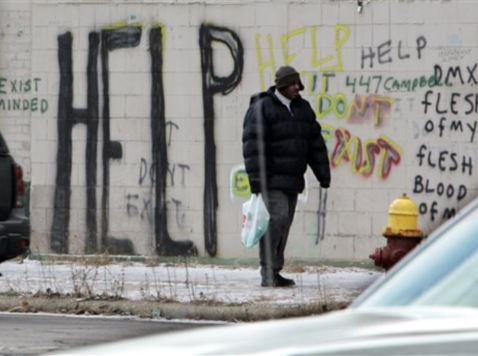In the days before Christmas, Mary Williams Walsh of The New York Times wrote several important news stories about the bankruptcy of the City of Detroit. She described how the nation’s largest banks have used the bogey man known as “systemic risk” to gain advantage over the other creditors in that case. The two reports “‘Safe Harbor’ in Bankruptcy Is Upended in Detroit Case” and “Detroit Wins $55 Million in Concessions From 2 Banks” deserve your close attention.
Back in the 1980s, the Fed and other regulators, assisted by some of the largest law firms in the US, started to lobby Congress to give derivative contracts special treatment in bankruptcy. The effort was especially focused on over the counter or “OTC” derivatives, a financial ghetto created with the blessing of the Fed to enable the big banks to earn surpra-normal profits to offset the lack of profitability in their core operations.
In order for the OTC casino to work, the derivatives contracts had to be given special priority in bankruptcy. Speculative derivative instruments such as credit default swaps (CDS), which caused the failure and government bailout of American International Group, could never exist in significant size were in not for the safe harbor from bankruptcy for derivatives created by Congress in the 1980s and 1990s. Members of Congress from both parties were paid very well for their treachery.
“Congress created the safe harbor for derivatives because they could pose systemic risk — if one bankrupt institution failed to make payment, it could swiftly bankrupt its trading partners, and they, in turn, might bankrupt their other trading partners, setting off a toxic cascade,” Williams Walsh writes. “But some bankruptcy experts question the fairness or even the effectiveness of this exception.”
The intellectual author of the “systemic risk” canard was my former boss, E. Gerald Corrigan, once the head of the Federal Reserve Bank of New York until his sudden resignation in 1993. Corrigan was the apprentice of none-other than Paul Volcker, the enabler of the big banks and father of the concept known as “Too Big to Fail.”
Volcker has always believed that in times of financial crisis large banks must be backstopped by the US government to avoid a financial contagion from destroying the economy. But Volcker’s encouragement of excess risk taking by the banks actually makes TBTF necessary. Read the 1993 Monograph “Gone Fishing” for background on how Volcker and Corrigan worked to protect the bad acts of the largest banks back in the 1980s and 1990s.
Two decades ago, members of Congress such as Robert Dole (R-KS) and Dennis DeConcini (D-AZ) carried the water for the largest banks, arguing that financial institutions could not be forced to wait along with other creditors in a bankruptcy. Derivative contracts were exempted from the automatic stay in bankruptcy under this argument. But the City of Detroit bankruptcy shows that the concern about protecting the flow of timely payments in the financial markets has also given banks super-creditor status in bankruptcy cases where the debtor was stupid enough to buy derivatives to “manage risk.”
The largest banks use these ersatz gaming contracts to prey upon unsophisticated public sector investors like cities and pension funds, pretending that the use of derivatives will somehow protect the client from risk. What often happens instead is that the client is left with a huge obligation to pay the derivative dealer bank on speculative positions that should have never been established in the first instance. As the Times describes, Detroit is being forced to borrow from one bank in order to pay off its gaming debts to two other large banks.
The legal safe harbor for derivatives contracts in bankruptcy enables a huge speculative industry and also represents an enormous subsidy to the largest TBTF banks. Seton Hall Professor Stephen J. Luben has discussed this issue in numerous articles and papers. Derivatives could never trade the volume and breadth of instruments that are seen today if these contracts were subject to the authority of the bankruptcy courts.
The safe harbor for derivatives in bankruptcy is essentially a tax on the other creditors of insolvent entities, who must shoulder losses while the counterparties in the derivatives markets get paid 100 cents on the dollar. The whole ridiculous argument made by Volcker, Corrigan and former Treasury Secretary Tim Geithner regarding systemic risk is ultimately why Goldman Sachs and other counterparties of AIG were paid in full after the US government rescue.
As I noted in a comment in Zero Hedge back in March 2013, “Question for Liz Warren: How Many Subsidies Does a Zombie Bank Need?,” the OTC derivatives market represents a huge public subsidy to the largest banks:
“While housing and other government subsidized loans are significant sources of subsidy for banks, the biggest subsidy of all for the TBTF banks is the OTC derivatives markets. The lack of capital required in these transactions and other special dispensations from the Fed provide the zombie banks with unlimited leverage and almost no public scrutiny. The fact that OTC contracts are exempt from the automatic stay in bankruptcy is a huge subsidy. The bilateral market structure is another. All of these retrograde market configurations were supported by the Fed over the past several decades.”
The role of the big banks in the Detroit bankruptcy is a monstrosity. We should all be grateful to Mary Williams Walsh and the Times for shining a light on this murky and obscure area of the world of bankruptcy law. Until Congress repeals the exemption from the automatic stay in bankruptcy for derivatives contracts, we cannot say that “Too Big to Fail” has been ended, as many public officials from Volcker to Geithner to the current Treasury Secretary Jack Lew like to pretend.

COMMENTS
Please let us know if you're having issues with commenting.